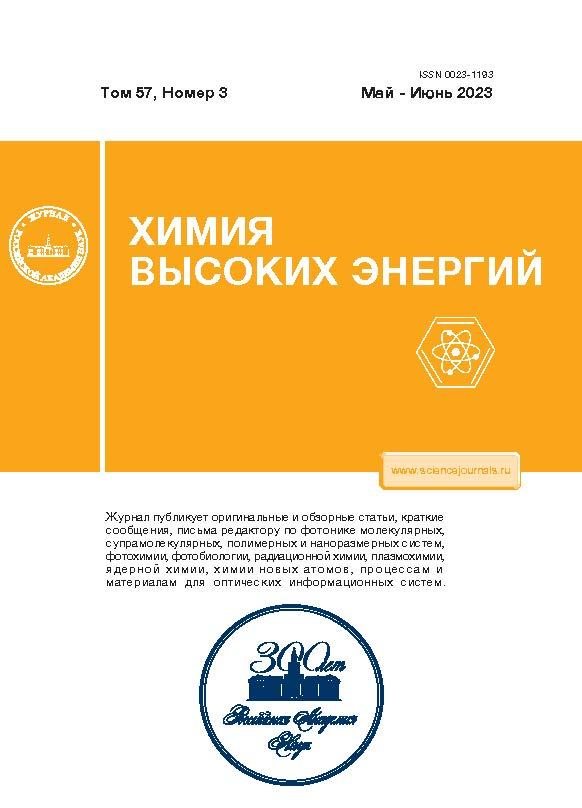Measurement of Photoelectrophysical Characteristics of Conductive Layers of CsPbBr3 Colloidal Quantum Dots
- Autores: Pevtsov D.N.1,2, Lochin G.A.1,2, Katsaba A.V.2,3, Brichkin S.B.1
-
Afiliações:
- Federal Research Center for Problems of Chemical Physics and Medicinal Chemistry, Russian Academy of Sciences
- Moscow Institute of Physics and Technology (National Research University)
- Lebedev Physical Institute, Russian Academy of Sciences
- Edição: Volume 57, Nº 3 (2023)
- Páginas: 186-190
- Seção: PHOTONICS
- URL: https://rjeid.com/0023-1193/article/view/661502
- DOI: https://doi.org/10.31857/S0023119323030117
- EDN: https://elibrary.ru/KDYBIW
- ID: 661502
Citar
Texto integral
Resumo
Colloidal quantum dots of perovskites having the chemical composition CsPbBr3 have been synthesized. For these particles, the average size of an ensemble of particles and sample polydispersity have been determined by steady-state spectrofluorometry. Conducting layers were made from the obtained particles, and the electrophysical characteristics of these layers were measured. The hole nature of the conductivity was
established, and the layer conductivity (0.04 S/m), mobility (0.8 cm2/(V s)), and number concentration of free charge carriers (3.01 × 1021 m−3) were measured. In accordance with published data, the measured mobility value is higher by one to two orders of magnitude than published typical values. It is shown that high polydispersity has a weak effect on the electrophysical and transport characteristics in the resulting layers.
Sobre autores
D. Pevtsov
Federal Research Center for Problems of Chemical Physics and Medicinal Chemistry, Russian Academy of Sciences; Moscow Institute of Physics and Technology (National Research University)
Email: pevtsov.dn@phystech.edu
Chernogolovka, Moscow oblast, 142432 Russia; Dolgoprudnyi, Moscow oblast, 141701 Russia
G. Lochin
Federal Research Center for Problems of Chemical Physics and Medicinal Chemistry, Russian Academy of Sciences; Moscow Institute of Physics and Technology (National Research University)
Email: pevtsov.dn@phystech.edu
Chernogolovka, Moscow oblast, 142432 Russia; Dolgoprudnyi, Moscow oblast, 141701 Russia
A. Katsaba
Moscow Institute of Physics and Technology (National Research University); Lebedev Physical Institute, Russian Academy of Sciences
Email: pevtsov.dn@phystech.edu
Dolgoprudnyi, Moscow oblast, 141701 Russia; Moscow, 119991 Russia
S. Brichkin
Federal Research Center for Problems of Chemical Physics and Medicinal Chemistry, Russian Academy of Sciences
Autor responsável pela correspondência
Email: pevtsov.dn@phystech.edu
Chernogolovka, Moscow oblast, 142432 Russia
Bibliografia
- Deschler F., Price M., Pathak S., Klintberg L.E., Jarasch D.-D., Higler R., Hüttner S., Leijtens T., Stranks S.D., Snaith H.J., Atatüre M., Phillips R.T., Friend R.H. // J. Phys. Chem. Lett. 2014. V. 5. P. 1421.
- Чикалова–Лузина О.П., Вяткин В.М., Щербаков И.П., Алешин А.Н. // Физика твердого тела. 2020. Т. 62. Вып. 8. С. 1333–1338.
- Ahmad S., Kanaujia P.K., Beeson H.J., Abate A., Deschler F., Credgington D., Steiner U., Prakash G.V., Baumberg J.J. // ACS Appl Mater. Interfaces. 2015. № 7. P. 25227.
- Ye J., Byranvand M.M., Martínez C.O., Hoye R.L., Saliba M., Polavarapu L. // Angewandte Chemie. № 133(40). P. 21804–21828.
- Zhang C., Wang S., Li X., Yuan M., Turyanska L., Yang X. // Advanced Functional Materials. № 30(31). P. 1910582.
- Kim J., Hu L., Chen H., Guan X., Anandan P.R., Li F., Wu T. // ACS Materials Letters. № 2(11). P. 1368-1374.
- Zhou S., Zhou G., Li Y., Xu X., Hsu Y. J., Xu J., Lu X. // ACS Energy Letters. № 5(8). P. 2614-2623.
- Иванчихина А.В., Пундиков К.С. // Химия высоких энергий. Т. 54. № 5. С. 361–369.
- Gilmore R.H., Lee E.M., Weidman M.C., Willard A.P., Tisdale W.A. // Nano letters. № 17(2). P. 893–901.
- Chang Lu, Marcus W. Wright, Xiao Ma et al. // Chemistry of Materials. 2019. V. 31 № 1. P. 62–67.
- Jorick Maes, Lieve Balcaen, Emile Drijvers et al. // J. Phys. Chemi. Let. 2018. V. 9. № 11. P. 3093–3097.
- Tovstun S.A., Gadomska A.V., Spirin M.G., Razumov V.F. // J. Luminescence. 2022. V. 252. P. 119420.
- Mandal A., Ghosh A., Senanayak S.P., Friend R.H., Bhattacharyya S. // J. Phys. Chem. Let. 2021. V. 12(5).
- Aleshin A.N., Shcherbakov I.P., Kirilenko D.A. et al. // Phys. Solid State. 2019. V. 61. P. 256–262.
Arquivos suplementares















